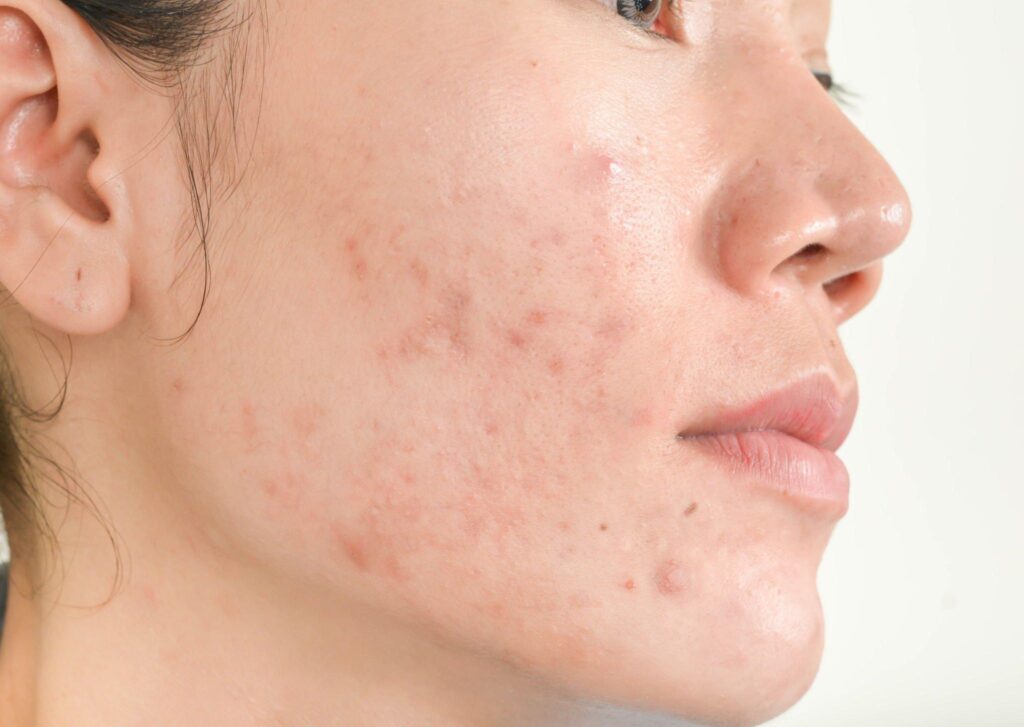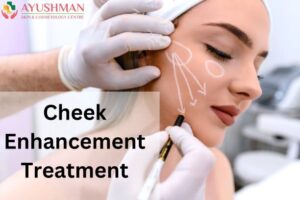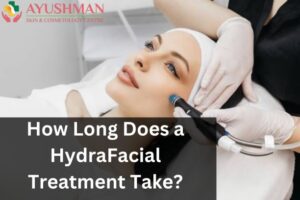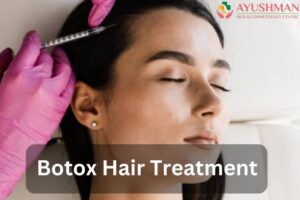Table of Content
- What is Acne?
- What are the types of acne?
- Symptoms of Acne
- Causes of Acne
- Types of Acne Treatment in Dwarka
- How Much Does Acne Treatment Cost?
- When to see a doctor?
Acne is a common skin condition that occurs when hair follicles under the skin become plugged with dead skin cells and oil. If you’re tired of home remedies to get rid of acne then you should go with acne treatments. There are different kinds of acne treatment in Dwarka, Delhi. Acne is a common skin condition that affects people of all ages. It can be a source of self-consciousness and frustration. Acne causes pimples, blackheads, and whiteheads. In this article, you will learn more about acne and its treatment.
Table of Contents
ToggleWhat is Acne?
Acne occurs when hair follicles clog oil and dead skin, which leads to outbreaks of lesions. The outbreak occurs on the face but it can also appear on the chest, shoulder, and back. When someone has a skin disease like acne, the hair, keratinocytes, and sebum stick together inside the pore. This stage prevents the keratinocytes (types of skin cells) from shedding and keeps the sebum from reaching the surface of the skin. Acne tends to go away by the time most people reach their thirties, but some people in their fifties continue to have acne problems.
What are the types of acne?
There are different types of acne, including:
- Fungal acne: Fungal acne which is also called Malassezia folliculitis occurs when yeast builds up in your hair follicles. These can cause itchy, clusters of small, and inflamed.
- Cystic: Cystic acne is caused by infection, injury, or other issues.
- Hormonal acne: It can affect adults who have an overproduction of sebum that plugs their skin pores.
- Nodular acne: This is a type of inflammatory acne that can cause pimples on the surface of your skin.
These forms of acne can affect your self-esteem. Both types of acne nodular and cystic acne can lead to permanent skin damage in the form of scarring. It’s best to seek help from your doctor early so they can determine the best acne treatment option for you.
Symptoms of Acne
Acne manifests through a variety of symptoms, each contributing to the overall appearance and discomfort associated with this common skin condition. Recognizing these symptoms is key to understanding and addressing acne effectively.
- Blackheads: Darkened pores caused by the oxidation of trapped oil and dead skin cells.
- Whiteheads: Small, white bumps resulting from blocked pores not exposed to air.
- Papules: Small, red, inflamed bumps without a visible center.
- Pustules: Red, tender bumps with a white or yellow center of pus.
- Nodules: Large, painful, solid lumps beneath the skin’s surface.
- Cysts: Deep, pus-filled lumps that can cause scarring and prolonged healing.
- Inflammation: General redness and swelling in affected areas.
- Pain and Tenderness: Acne lesions can be sensitive and painful, particularly when inflamed.
- Itching: Some individuals may experience itching around acne-affected areas.
- Scarring: Severe or untreated acne can lead to lasting scars, impacting skin texture.
- Increased Oil Production: Excess sebum production contributes to clogged pores.
- Hormonal Changes: Fluctuations in hormones, particularly during puberty or menstruation, can trigger acne.
It’s important to note that symptoms may vary in severity, and individuals may experience a combination of these manifestations. Seeking professional advice from a dermatologist can help tailor an effective treatment plan based on the specific symptoms and skin type.
Causes of Acne
Researchers and doctors believe that one or more of the following can lead to the development of acne. Here are four main factors that cause acne:
- Sebum (Excess oil) production
- Buildup of dead skin cells in the pore
- Bacteria
- Inflammation
Typically acne appears on those areas of skin where the most oil glands such as face, forehead, upper back, shoulders, and chest. Oil glands are connected to hair follicles. The hair follicle wall may bump and produce a whitehead. Or the plug may open to the surface and darken, causing a blackhead. A blackhead looks like dirt stuck in the skin pores, but actually, the pore is congested with oil and bacteria. It turns brown when it’s exposed to the air.
The following factors may trigger or worsen your acne:
- Hormonal changes: Androgens are hormones that increase in both girls and boys normally during puberty and cause the sebaceous glands to enlarge and make more sebum. Hormone changes during pregnancy, and midlife, can lead to acne.
- Medications: Medications that contain corticosteroids, lithium, or testosterone.
- Diet: Consuming carbohydrate-rich foods may worsen your acne, such as fast food, chips, and bread.
- Age: Teenagers get acne more easily than other age groups.
Types of Acne Treatment in Dwarka
If you want to get acne-free skin and you’re tired of nonprescription acne products that haven’t helped you. In this condition, you should ask your doctor about the prescription. A dermatologist can help you control your acne, make scars less noticeable, and avoid scarring or other damage to your skin.
Acne treatment reduces swelling and oil production by treating bacterial infections. You may not see the results for 4-8 weeks with most prescription acne drugs. It may take many months or a year for you to clear your acne completely.
The treatment the doctor recommends depends on your acne type and your age. Seek advice from your doctor about the benefits and risks of medications and other treatments you are considering. You will make follow-up appointments with your dermatologist every three to six months until your skin improves.
Acne, a prevalent skin condition, necessitates a nuanced approach to treatment. Various types of acne treatments target different aspects of its development, offering solutions for individuals with diverse needs.
Topical Treatments:
- Benzoyl peroxide: Effective in reducing acne-causing bacteria
- Antibiotics: Help to kill excess skin bacteria and reduce inflammation and redness.
- Retinoids: Derived from vitamin A, these promote cell turnover and prevent clogged pores.
- Azelaic acid and salicylic acid: It helps to manage discoloration that occurs with some types of acne.
- Dapsone: The doctor may recommend you dapsone (Aczone) gel twice daily for inflammatory acne.
Oral Medications:
- Antibiotics: Combat bacteria contributing to acne.
- Hormonal treatment: Anti-androgen medications or birth control pills for hormonal acne.
Chemical Peels:
Chemical peels are one of the best acne treatments. This procedure involves the application of chemical solutions to exfoliate and improve skin texture.
Lifestyle Adjustments:
- Dietary changes: Limiting high-sugar and dairy foods.
- Stress management: Use techniques like meditation to reduce stress-related breakouts.
Complementary Therapies:
- Tea tree oil: Exhibits antimicrobial properties.
- Zinc supplements: Supports overall skin health.
It is crucial to understand the severity and types of acne in determining the most effective treatment plan. Consulting with a dermatologist ensures personalized recommendations for optimal results.
How Much Does Acne Treatment Cost?
Now you know about acne and types of acne. Let’s discuss in detail the cost of different treatments.
- Laser acne treatment costs from Rs. 2000 to Rs. 15,000.
- Chemical peels cost from Rs. 1,000 to Rs. 10,000 depending on the area of the treatment.
- Comedone extraction cost may vary from Rs. 1,100 to Rs. 5,000 per session.
You have to take at least 5 to 6 months of treatment to get better results. After acne treatment in Dwarka, maintenance is advised by the doctor to control new acne lesions. Make sure you get acne treatments done with any dermatologist so that you can understand the treatments and get the desired results. The cost of acne treatment can vary from clinic to clinic and other following factors:
- Doctor: The doctor who will treat your acne.
- Acne: The severity and type of your acne.
- Area: Cost also depends on the area to be treated, for the face it will cost less than arms and back.
- Skin Type: The skin type is also one of the factors for the acne treatment cost.
- Treatment: It also depends on which treatment you are undergoing. If you are taking laser and PRP it will cost you more than chemical peels and other treatments.
It is advisable to consult a board-certified dermatologist to find out how much acne treatment in Dwarka will cost you.
When to see a doctor?
If self-care remedies are not clearing your acne then you should see a dermatologist. Your dermatologist will prescribe you stronger medications. If acne persists, you may have to seek medical treatment from a dermatologist.
The FDA (Food and Drug Administration) warns that some popular non-prescription acne cleaners, lotions, and other skin products can cause a serious reaction. This kind of reaction is quite rare, so don’t confuse it with any itchiness, redness, or irritation that occurs in areas where you’ve applied products or medications.
FAQ’s (Acne Treatment)
Q: Which treatment is best for acne?
A: Tetracycline or macrolide is one of the best acne treatments. A macrolide might be an option for those who can not take tetracyclines, including children under 8 years old and pregnant women.
Q: Which doctor is best for acne treatment?
A: You should seek help from a dermatologist. They can diagnose you by looking at your breakouts. Dermatologists will also note where the breakouts appear on your skin and what kinds of acne you have. This helps your healthcare provider to create an effective acne treatment plan.
Q: How much does acne treatment cost in Delhi?
A: Acne treatment costs can range from Rs. 1,500 to Rs. 5,000 per session. It depends on the type of treatment you will take.
Q: Is acne a serious problem?
A: It depends on its severity, acne can scar the skin and emotional distress. If you start your acne treatment earlier, it lowers your risk of acne problems.




